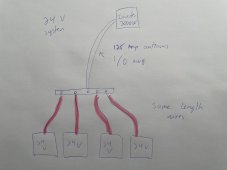Hi everyone,
Please see attached hand drawn schema. I would like to parallel my 24V batteries via a busbar. This busbar will be connected to a 3000W inverter, so I need a wire able to hold 125AMP continous. I will go with a 1/0 AWG.
My question is about the ones in pink... batteries to busbar (all the same length of course). Am I right to think that max current pulled on each cable will be 125/4 = 31 AMP ? Can I connect each battery to busbar with a 6 AWG wire? If yes, I suppose that I should place a 50A fuse on each?
Thanks for your help !
Please see attached hand drawn schema. I would like to parallel my 24V batteries via a busbar. This busbar will be connected to a 3000W inverter, so I need a wire able to hold 125AMP continous. I will go with a 1/0 AWG.
My question is about the ones in pink... batteries to busbar (all the same length of course). Am I right to think that max current pulled on each cable will be 125/4 = 31 AMP ? Can I connect each battery to busbar with a 6 AWG wire? If yes, I suppose that I should place a 50A fuse on each?
Thanks for your help !



